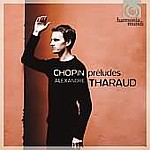The best recordings of Chopin’s Op. 28 Preludes involve strong, captivating, and individual interpretive personalities, all of whom manage to project an intense awareness of and feeling for what the composer wrote. Think of classicists such as Petri, Pollini, and Moravec, free spirits on the order of Cortot, François, Argerich, and Sokolov, or Arrau’s Janus-faced pedant and maverick. Alexandre Tharaud easily earns a place among his illustrious predecessors, while bringing his own ideas to the table.
Tharaud grabs No. 1’s agitato directive and runs away with it, making the right hand’s triplet and quintuplet groupings distinctly audible. Likewise, the pianist feels No. 2 in cut time as written, and looks the pungent left-hand dissonant clashes straight in the eye. No. 3’s quicksilver leggiero patterns are marvelously varied in articulation and color, and in No. 4, Tharaud achieves Chopin’s espressivo desire via discreet rubato and subtle textural changes within the steady left-hand chords. He teasingly prolongs No. 7’s first note, only to play the prelude simply.
Most pianists drive through No. 12’s first big climax at measure 21. Not Tharaud, who leans into the grace notes in order to underline the music’s momentary mazurka-like feeling; it’s an odd yet convincing effect. No. 16 is not so fiery and dynamic as it should be, but No. 19’s multi-hued legato results from Tharaud’s close observation of the composer’s pedal markings. No. 21’s cantabile demeanor acquires an unusual forward moving urgency that naturally dovetails into No. 22’s unrelenting agitation.
A gorgeous reading of Mompou’s miniature based on Prelude No. 4 provides a resting point from which the Three Nouvelles Etudes spring with admirable profile and specificity. Tharaud’s line-oriented deliberation in the Op. 45 C-sharp minor Prelude brings out the Bach in Chopin, or perhaps the Chopin in Brahms’ Op. 76 No. 1 Capriccio? Incidentally, the Steinway grand Tharaud uses for these sessions conveys a vibrant, slightly twangy and characterful sound, ideally captured in warm, ample, and closely detailed engineering. Even if you already own a reference Chopin Preludes edition, seriously consider this most stimulating and rewarding release–delectable Mompou tidbits, artsy cover photo and all. [3/17/2008]
































